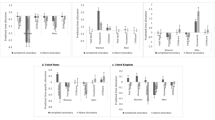Abstract
A proportional shares model of daily time allocation is developed and applied to the analysis of joint activity participation between adult household members. The model is unique in its simultaneous representation of each decision maker's decisions concerning independent activity participation, allocation of time to joint activities, and the interplay between individual and joint activities. Further, the model structure ensures that predicted shares of joint activity outcomes be the same for both decision makers, an improvement over models that do not make interpersonal linkages explicit. The empirical analysis of travel diary data shows that employment commitments and childcare responsibilities have significant effects on tradeoffs between joint and independent activities. In addition, evidence is presented for the continued relevance of gender-based role differences in caring for children and employment participation.
Similar content being viewed by others
References
Aptech Systems, Inc (1995) GAUSS. Maple Valley, Washington: Aptech Systems, Inc.
Becker GS (1965) A theory of the allocation of time. The Economic Journal 75(299): 493–517.
Ben-Akiva M & Lerman SR (1985) Discrete Choice Analysis: Theory and Application to Travel Demand. Cambridge, MA: The MIT Press.
Bhat CR (1991) Toward a model of activity program generation. PhD dissertation, Northwestern University.
Bhat CR & Koppelman FS (1993) A conceptual framework of individual activity program generation. Transportation Research A 27(6): 433–446.
Browning M, Bourguinon F, Chiappori PA & Lechene V (1994) Incomes and outcomes: a structural model of intrahousehold allocation. The Journal of Political Economy 102(6): 1067–1096.
Browning M & Chiappori PA (1998) Efficient intra-household allocations: a general characterization and empirical tests. Econometrica 66(6): 1241–1278.
Chandraskharan B & Goulias KG (1999) Exploratory longitudinal analysis of solo and joint trip making in the Puget Sound Transportation Panel. Transportation Research Record 1676: 77–85.
Fujii S, Kitamura R & Kishizawa K (1999) Analysis of individuals’ joint activity engagement using a model system of activity-travel behavior and time use. Transportation Research Record 1676: 11–19.
Golob TF & McNally MG (1997) A model of activity participation and travel interactions between household heads. Transportation Research B 31(3): 177–194.
Hamed MM & Mannering FL (1993) Modeling travelers’ postwork activity involvement: toward a new methodology. Transportation Science 27(4): 381–394.
Hausman JA, Leonard GK & McFadden D (1995) A utility-consistent, combined discrete choice and count data model assessing recreational use losses due to natural resource damage. Journal of Public Economics 56: 1–30.
Hirsh M, Prashker JN & Ben-Akiva M (1986) Dynamic model of weekly activity pattern. Transportation Science 20(1): 24–36.
Hsiao C (1986) Analysis of Panel Data. New York: Cambridge University Press.
Jones PM, Dix MC, Clarke MI & Heggie IG (1983) Understanding Travel Behavior. Aldershot, UK: Gower Publishing Co, Ltd.
Koppelman FS, Bhat C, Sethi V & Williams B (2000) Self instruction course in mode choice modeling. US Department of Transportation.
Kostyniuk LP & Kitamura R (1983) An empirical investigation of household time space paths. In: Carpenter S & Jones P (eds), Recent Advances in Travel Demand Analysis (pp 266–289). Aldershot, UK: Gower Publishing Co, Ltd.
McFadden, DL (1978) Modeling the choice of residential location. In: Karlquist A et al. (eds) Spatial Interaction Theory and Planning Models (pp 75–96). Amsterdam: North Holland.
McFadden, DL (1981) Econometric models of probabilistic choice. In: Manski CF & McFadden DL (eds) Structural Analysis of Discrete Data with Econometric Applications (pp 198–271). Cambridge, MA: The MIT Press.
Montemarquette C & Monty L (1987) An empirical model of a household’s choice of activities. Journal of Applied Econometrics 2(2): 145–158.
Murakami E & Watterson WT (1990) Developing a household travel panel survey for the Puget Sound Region. Transportation Research Record 1285: 40–46.
Pollak RA & Wachter ML (1975) The relevance of the household production function and its implications for the allocation of time. The Journal of Political Economy 83(2): 255–278.
Revelt D & Train K (1998) Mixed logit with repeated choices: household’s choice of appliance efficiency level. Review of Economics and Statistics 76: 591–608.
Townsend, TA (1987) The effects of household characteristics on the multi-day time allocations and travel/activity patterns of households and their members. PhD dissertation, Northwestern University.
Wen, C-H & Koppelman FS (1999) An integrated system of stop generation and tour formation for the analysis of activity and travel patterns. Transportation Research Record 1676: 136–144.
Author information
Authors and Affiliations
Rights and permissions
About this article
Cite this article
Gliebe, J.P., Koppelman, F.S. A model of joint activity participation between household members. Transportation 29, 49–72 (2002). https://doi.org/10.1023/A:1012995509777
Issue Date:
DOI: https://doi.org/10.1023/A:1012995509777




